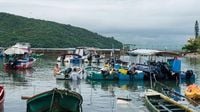As dawn broke on Monday, September 22, 2025, the northern Philippines faced the full force of Super Typhoon Ragasa—known locally as Nando—a storm described by meteorologists as potentially catastrophic and the strongest of the year so far. Packing sustained winds of 215 to 267 kilometers per hour (134 to 165 miles per hour) and gusts up to 315 kilometers per hour (195 miles per hour), Ragasa made landfall over Panuitan Island in Cagayan province, unleashing devastation across a region already reeling from weeks of flooding and political turmoil.
According to the Philippine weather bureau PAGASA, the typhoon’s outer bands were so intense that they generated rainfall totals exceeding 400 millimeters (15 inches) in some parts of northern Luzon. The agency issued its highest tropical cyclone wind signal No. 5 for the northern Babuyan Islands, warning of “potentially very destructive” conditions and a “high risk of life-threatening storm surges.” Coastal inundation was a certainty, with peak waves expected to exceed three meters (nearly 10 feet), threatening low-lying communities in Cagayan, Batanes, Ilocos Norte, and Ilocos Sur.
As the winds howled, more than 10,000 people across northern and central Luzon fled their homes, seeking safety in emergency shelters or with relatives further inland. The Department of the Interior and Local Government pleaded with residents to heed evacuation warnings, stating, “Homes and property can be rebuilt, but lives lost can never be replaced.” In Cagayan alone, over 8,200 people were evacuated, while Apayao province—prone to flash floods and landslides—saw 1,220 residents seek refuge.
Power outages swept across Calayan Island and the mountain province of Apayao, plunging thousands into darkness as the typhoon’s eyewall battered the coast. Schools and government offices in large parts of the country, including the capital Manila, were shuttered by order of President Ferdinand Marcos Jr., who suspended government work and classes across 29 provinces in Luzon. Domestic flights were canceled, and fishing boats and inter-island ferries were grounded due to the treacherous seas, leaving many communities isolated and bracing for the worst.
The remote Batanes and Babuyan Islands, home to about 20,000 people—many living in poverty—bore the brunt of Ragasa’s landfall. Authorities warned of widespread flooding, landslides, and severe damage to homes and infrastructure, with hospitals in northern Cagayan placed on high alert. Flood warnings blanketed low-lying areas as Ragasa’s winds intensified the already fierce monsoon rains, exacerbating the threat of disaster.
Yet the typhoon’s impact extended far beyond the Philippines. Taiwan, directly in the storm’s projected path, scrambled to evacuate nearly 300 residents from Hualien County in the east. The Central Weather Administration warned that Ragasa would approach Taiwan’s offshore by Monday morning, unleashing heavy rains across the island’s east coast. Forest areas and nature trails in southern and eastern Taiwan were closed, and ferry services suspended as authorities braced for flash floods and landslides.
In Hong Kong, the government issued dire warnings, forecasting rapidly deteriorating weather by Tuesday and Wednesday. The Hong Kong Observatory predicted gale-force winds and storm surges reminiscent of Typhoon Mangkhut in 2018, which left a trail of destruction in its wake. Local officials distributed more than double the usual number of sandbags to flood-prone districts, and residents rushed to stock up on food and supplies. Cathay Pacific, the city’s flagship airline, announced the cancellation of 500 flights, while Hong Kong Airlines halted all departures starting Tuesday evening. All schools in Hong Kong were ordered closed from Tuesday through Wednesday, and temporary shelters were established to house those displaced by the storm.
Across the Pearl River Delta, authorities in mainland China’s Guangdong province prepared for what they described as a “catastrophic and large-scale disaster.” The cities of Jiangmen, Yangjiang, Zhongshan, and Zhuhai suspended schools, offices, factories, and public transportation. Officials in Shenzhen—a megacity of 17.5 million—planned to evacuate 400,000 people from low-lying and coastal neighborhoods. Residents were urged to reinforce doors and windows, stockpile emergency supplies, and avoid underground areas. Railway services across Guangdong were set to be gradually suspended, and flood-prone areas were put on high alert.
As Ragasa churned westward across the South China Sea at roughly 20 to 23 kilometers per hour (12 to 14 miles per hour), meteorologists warned that its outer bands would unleash torrential rains and damaging winds on its way toward southern China and possibly Vietnam. The Joint Typhoon Warning Center predicted that Ragasa would skirt south of Taiwan and Hong Kong early Wednesday, with maximum winds of just over 200 kilometers per hour (124 miles per hour) and gusts up to 250 kilometers per hour (155 miles per hour)—still a formidable threat to millions in the region.
While the typhoon’s immediate impact was measured in winds and waves, its arrival also reignited simmering political tensions in the Philippines. On Sunday, tens of thousands took to the streets in Manila and other cities, protesting against a corruption scandal involving billions of dollars lost to incomplete or “ghost” flood control projects. The scandal, which has implicated multiple lawmakers, has fueled national outrage and left many questioning the government’s ability to protect its citizens from disasters. As protesters chanted for accountability, Secretary of the Interior Jonvic Remulla emphasized the urgency of evacuation, stating, “Local officials must waste no time in moving families out of danger zones.”
Scientists and climate experts have pointed to Ragasa as a stark reminder of the growing intensity of storms fueled by global warming. According to the Hong Kong Observatory, “Extreme precipitation events have become more frequent. The hourly rainfall record at the Hong Kong Observatory Headquarters used to be broken once every few decades in the past. However, the record has been broken several times in the recent few decades.” The western Pacific, the most active tropical basin on Earth, has seen ocean temperatures rise to record levels for eight consecutive years, providing the energy needed for storms like Ragasa to rapidly intensify. The Philippine archipelago, sitting squarely in the Pacific cyclone belt, now faces an escalating cycle of devastation, with millions living in disaster-prone areas and little respite between storms.
Despite the chaos, communities across the region rallied to prepare and protect the most vulnerable. Emergency crews, local officials, and volunteers worked through the night, reinforcing shelters, distributing supplies, and ensuring that those at greatest risk were moved to safety. The resilience on display—against a backdrop of political scandal and climate uncertainty—spoke volumes about the spirit of those in Ragasa’s path.
As the storm’s winds began to subside and the floodwaters receded, the true scale of Ragasa’s impact remained to be seen. For now, the focus was on survival and recovery, as millions from the Philippines to southern China braced for what comes next in a region where the only certainty is that the storms will keep coming.



